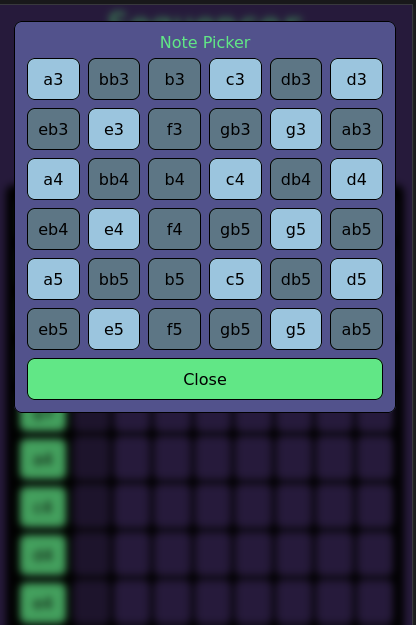Synth-App
Overview
Synth-App is a musical wep app that allows users to play with musical tools in the browser. It uses Tone.js, a library built upon the WebAudio API, to create sound, loops, and timing, and Recoil to manage state.
At the moment, there is only one musical tool. However, the intention is to build a series of musical tools the user can utilize.
With that end in mind, the project is built using Next.js to allow it to scale easily to a larger app, eventually with a login option that will allow users to save their work.


Purpose/Context
I wanted to create something fun, and also something that I could use as a sort of harmonic metronome for musical practice.
With this app, the user can create a sequence of notes/chords in rhythm, and play along.
Additionally, this sort of project will be easily extensible, and I plan to add more features in the future.
Development
Tools and Methodologies
- React/Typescript
- Next.js
- Tone.js
- Tailwind/HeadlessUI
- Recoil
Tone.js
I had already built an synthesizer app with the native WebAudio API. One of the major issues with audio is scheduling events, which is not easily done with JavaScript in the browser. The Tone.js library, among many features, schedules all events along a single timeline called Transport. This was my primary motivation for using this library. Initially, I had to iterate over different ideas for a sequencer, and it took some time to learn how to use Tone.js to do what I wanted. There were further problems incorporating it with React, Next.js, and Recoil as well.
Recoil
My concept for the app was that the user could
have fine-grained control over a series of
synthesizers, beats, and events.
Anticipating that there might be hundreds of components
with highly individual states,
I decided to manage my state with Recoil,
which isolates individual 'atoms' of state
outside of React and allows you to access
and manipulate these atoms in a very similar way
to the React useState() hook.
This allows for surgical precision on state updates,
but does come at the cost of creating a sort
of graph of atomic state.
This also lead to quite a lot of complications
when handling Tone.js events, as I will discuss later.
Tailwind/HeadlessUI
I wanted to have a clean UI that was also accessible. I love how Tailwind makes it easy to have consistent, responsive styles. Originally, I built a modal dialog for the 'Note Picker' with pure Tailwind. However, I wanted to also add a portal, and ensure it was accessible. This lead me to HeadlessUI, which is an un-styled, bare-bones UI library built by the Tailwind team. This is great because it allows me to have a lot of control over the design, while also a lot of built in accessibility support, without having to add a giant UI library like Chakra or Material.
TypeScript
I love TypeScript. While working at Encore, we transitioned our codebase from JavaScript to TypeScript and saw and immediate increase in code quality and maintainability. It is so much easier to create and maintain a complex codebase when types are strictly defined. So I went with TypeScript.
Final Touches
I used Tabler-Icons-React to add some clean icons to the play button, coolers.io to help me find a nice color scheme, and went with a mobile-first layout.
There is still a lot I would like to do with this app, but as it is, it is functional and fun to play with.
Challenges
Tone.js
I had to spend a lot of time playing with the Tone.js API,
exploring how to use it with React/Next and my chosen state management library.
One major challenge was styling the currently active beat as the Transport timeline
progressed.
I tried to manage this by scheduling an event along the Transport timeline
that would update some state in the note components,
however this was buggy.
Digging deeply into the tone.js docs,
I found that the library exposes the current beat along the Transport,
and I was able to solve this issue.
Another issue is that Tone.js relies on the WebAudio API,
which of course doesn't exist at compile time.
For this reason, I all of my components relying on Tone.js are
dynamically imported, and then rendered within Suspense
to ensure they do not render until the window object is available.
Recoil
I chose recoil because it allows for atomic control of state, meaning state can be updated outside of the component tree. A graph of dependencies can be managed so that certain atoms can cause state updates across the app when necessary. I hoped this would isolate components and ensure that only specific parts of the DOM would rerender. It allowed me to keep most of my central business logic for the synthesizer in only one tiny component (the 'start' button), and isolated rows of notes, ensuring minimal rerenders would occur. However, it does come at cognitive cost of mapping all these state dependencies in a graph, which I plan to do on the projects README.md.
Conclusion
This was a sometimes frustrating but in the end satisfying project. One key take away for me is to not over0plan and over optimise a code base. I believe if I had begun with a simple implementation of my end goal in a single component without managing state outside of basic react hooks/props, I might have made faster progress. Quite a few times I had to backtrack, undo early optimisations, and rethink my entire approach.
Credits
- Lead Developer: Raffaele Cataldo